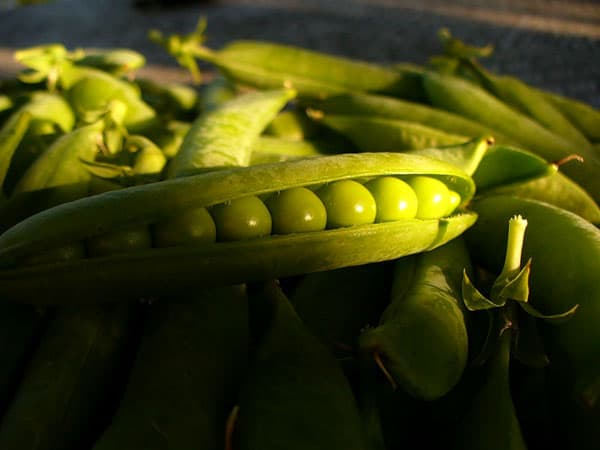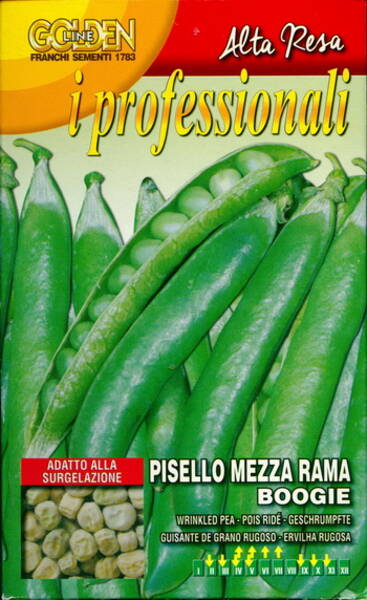Mid-late variety (64-72 days) of brain green peas (sortotype "Afila" - low-leaved), intended for gradual harvesting. Variety with wrinkled seeds.
Plant of medium height: 65-75 cm. Pods are dark green (rounded with a sharp tip), each of which contains 7-9 peas. Excellent yield.
This variety is highly resistant to the main diseases of legumes. Excellent both fresh and canned or frozen.
1.0 g = 3-6 seeds.

* Care, watering and fertilizing.
Peas are demanding moisture, especially during seed germination, and are also very photophilous. Consumes a large number of nutrients from the soil. It especially needs phosphate and potash fertilizers.
Nitrogen fertilizers are used only on soils poor in nitrogen. Peas do not require organic fertilizers. It is recommended to cultivate it in the second year after manure application.
In addition to phosphorus and nitrogen fertilizers applied during soil preparation or immediately after sowing, top dressing is practised during the growing season (at the rate of 5 g of nitrogen per 1 sq. M). No more nitrogen fertilizer should be applied. An excess of it will lead to excessive development of green mass and delayed ripening.
Attention! Peas need magnesium, keep this in mind when choosing mineral fertilizers. The reaction of the soil should be neutral or slightly alkaline. If liming is necessary, then it should be carried out in the previous year.
Seeds begin to germinate at temperatures from +1°С to +6°С, the optimum temperature for seed germination is about +18°С. Depending on the temperature, seedlings appear on the 5th, 7th, 12th and 15th day. Peas develop best at a temperature of +15+20°C. Seedlings tolerate short-term frosts down to -6°C.
Abundant summer precipitation is favourable for its development. But on heavy, poorly drained soils with close-standing groundwater, when waterlogged, the peas turn yellow, and the root system may die. Plants are highly susceptible to fungal diseases.
When the pea bushes reach a height of 15 cm, they should be spudded. This will increase the resistance of plants to lodging. In addition, weeds will be destroyed. When sowing "belts", only one side of each row is spudded, while tilting the plants so that they mutually support each other. The soil, while the plants are intertwined, is constantly loosened. Before flowering, peas do not need watering. The need for water increases sharply from the moment the ovaries are formed. When the pea grain gains mass, they need to be watered twice (20 liters of water per 1 m2). Irrigation before and during flowering prolongs the flowering period. And thus lengthens the harvest period. Peas are usually wound on pegs so that the plants trudge along them. But this is not necessary, since the new varieties are rather short (65-80 cm) and they do not need props.
Harvest.
Peas are among the early vegetables of open ground. Harvesting begins in late June - early July. Harvesting of shelling varieties for green peas begins when the grains in the pod reach their maximum size and juicy and green leaves are formed (without signs of a grid on the surface). The appearance of a white mesh on the pods is a sign that the peas are overripe.
Pea pods are harvested when they are green, flat, fleshy, tender and juicy, with underdeveloped seeds.
Harvesting pods of shelling and sugar varieties is carried out several times per season (as they mature). The yield of green peas in pods and shoulder blades averages 1-1.5 kg per 1 sq. m.
Pods must be removed carefully. Collections are repeated every 3 days. It is best to harvest the beans early in the morning, as they will wither quickly in hot weather. Green peas are stored for 10-12 hours, and shelled - 3-4 hours, after which it becomes starchy and less sweet.
Peas not used during this period must either be dried or preserved. With the correct distribution of planting dates during the growing season and the selection of appropriate varieties, fresh peas can be used for 90-100 days.











